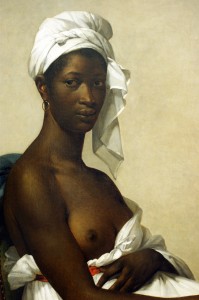
Solomon Franco, who died in 1721 at age 31, was among a minority of Jamaican Jewish men during the eighteenth century who resided on the island without a wife and children. He lived out his short days as a merchant in the then recently rebuilt town of Port Royal where the remnants of a Jewish community still existed after the devastating earthquake and tidal wave of 1692. Although without a nuclear family, he was not alone on the island. Solomon had five sisters scattered throughout the western Sephardic Diaspora, including one who lived nearby in Spanish Town. In his home he lived with his enslaved domestic servant, known only as Anne, who was there to care for him during the last days of his life. Along with his five sisters, Anne was the only other beneficiary of Solomon’s modest estate.
Anne and Solomon developed a close bond that bordered on familial. When he knew his death to be imminent, he freed her from slavery with a deed of manumission. But as much as Solomon appears to have been dependent on Anne, she seems to have been equally dependent on him. After her manumission, she indentured herself to Solomon for a period of three years (he later released her from this indenture in his will). As a reward for her “faithful service,” Solomon also bequeathed to her fifty pounds, all of his household goods, and further stipulated that she be allowed to “take away . . . my said house hold stuff and also . . . Anne’s chests and trunks without being searched by any person whatsoever.” His concern over Anne being searched by his executors implies the expectation of mistrust that he intended to prevent.
It is clear that, despite the underlining inequality between Solomon and Anne and the exploitive reality of slave ownership, Solomon and Anne had cultivated a close and mutually beneficial relationship. Unlike several other West Indian Jewish male testators during this period, Solomon never identified Anne a sexual partner nor recognized any natural children from her. It can therefore not be assumed that Anne was his concubine—though domestic labor was often synonymous with this type of sexual exploitation. Their relationship, while unequal, seems to have been built on a sense of shared necessity.
Though cases like Solomon and Anne reveal an almost sentimental relationship between a Jewish owner and an enslaved domestic servant it should not be taken as evidence that colonial West Indian Jews naturally treated their enslaved labor better than non-Jews. A prevailing historiographic narrative has it that Jews, informed by a sense of religious humanitarianism, both treated the enslaved with benevolence and manumitted them with greater frequency than non-Jews. On the contrary, it is not difficult to demonstrate that an ethos of accumulation prevailed among Jews, who mirrored their non-Jewish neighbors in their patterns of slave ownership throughout the colonial Atlantic world.
A sample of three hundred last will and testaments of eighteenth-century Jewish testators from Jamaica and Barbados reveals that, in fact, slaves were only manumitted by 41 testators while they were bequeathed to beneficiaries by 172. In other words, the enslaved were thirteen times more likely to be inherited by Jews than they were to be freed by them. The most likely cause of manumission of enslaved children was biological paternity. Manumission records reveal that Jewish men freed children of color four times more frequently than they manumitted black children. However, sexual liaisons did not always produce affectivity or even a sense of responsibility toward “reputed” offspring. In one case, Jacob Bravo, a married man with two Jewish children, stipulated in his will that his enslaved mistress Betty and their two children––with whom he lived on his plantation “Lucy Lawn”––be sold after his death for the “highest and best price.”
Jamaica, unlike Barbados, experienced a major slave revolt at least once a decade throughout the colonial period, fueling an environment of intense hostility between owners and the enslaved. In some cases, traces of hostility, and even brutality, appeared between the enslaved and their Jewish owners as well. In one case from 1765, the married Kingston shopkeeper Moses Levy Alvares—one of the spiritual leaders of the Jamaican Jewish community—bequeathed an enslaved “negro” woman with his initials, “MA,” branded on her shoulder, to his “quadroon” daughter. In another case, an enslaved woman named Jenny was tried and convicted in a slave court for poisoning the wife of her Jewish owner, Abraham Nunes Henriques. Unfortunately, her fate along with the fate of Mrs. Henriques, is unknown. Jewish men and women placed advertisements for runaway slaves in late eighteenth-century West Indian newspapers with as much frequency as non-Jews.
Despite these inevitable hostilities, enslaved domestic laborers were a quotidian presence in Jewish homes and an integral part of the household rhythm and routine, touching the lives of nearly every Jew residing in the colonial British West Indies. Household laborers prepared their food—undoubtedly cultivating a familiarity with Jewish dietary restrictions—and in some cases even nursed their children. Domestic laborers, whether enslaved or free, were therefore often absorbed into the family as unrelated extended kin.
The West Indies were infamously renowned in the eighteenth century for the sexual libertinism of the creole population. Concubinage between white men and women of color was a pervasive social reality. Though not often acknowledged, Jewish men, in at least fourteen out of three hundred wills—some of the testators even married with children—incorporated their natural children of color into their families through bequests of both monetary and material legacies. The Kingston merchant Moses Gomes Fonseca, as he manumitted his three daughters from his long-time concubine Eleanor Minol Thomas in 1795, incorporated the highly uncommon phrase, “the natural love and affection which I have and bear for my three mulatto children.” In other cases, such as with Solomon and Anne, Jews acknowledged their freed domestic servants with inheritance alongside and in equal measures to related Jewish kin, raising new questions about the singular role of ethnicity as a marker of Spanish-Portuguese identity and familial belonging.
Some Jewish testators even adopted parental postures toward the unrelated enslaved children who grew up in their homes. The Jewish testator Rachel Nunes ensured the fate of three enslaved black children who grew up in her home by bequeathing them to the wardens of the Jewish community in 1796. She referred to them as her “children as I regard them.” The testator Grace Lopes Torres cared for the “reputed” son of her married cousin as her “adopted son.”
The inequality of West Indian slave society engendered conditions where the enslaved could be brutalized, commodified, and sexually exploited by white men and women with near immunity. Jews were no exception to the rule. But, it is unfaithful to the social realities of the time to characterize West Indian slave society as dominated by an either/or ethos of accumulation versus an ethos of sentiment. Both prevailed and both could exist simultaneously within a single individual. Solomon Franco leveraged his position of power for the mutual benefit of both himself and Anne. They were reliant on each other, and Solomon seems to have viewed Anne as nothing less than a member of his family.

